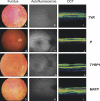Molecular and clinical characterization of albinism in a large cohort of Italian patients
- PMID: 20861488
- PMCID: PMC3101674
- DOI: 10.1167/iovs.10-6091
Molecular and clinical characterization of albinism in a large cohort of Italian patients
Abstract
Purpose: The purpose of this study was to identify the molecular basis of albinism in a large cohort of Italian patients showing typical ocular landmarks of the disease and to provide a full characterization of the clinical ophthalmic manifestations.
Methods: DNA samples from 45 patients with ocular manifestations of albinism were analyzed by direct sequencing analysis of five genes responsible for albinism: TYR, P, TYRP1, SLC45A2 (MATP), and OA1. All patients studied showed a variable degree of skin and hair hypopigmentation. Eighteen patients with distinct mutations in each gene associated with OCA were evaluated by detailed ophthalmic analysis, optical coherence tomography (OCT), and fundus autofluorescence.
Results: Disease-causing mutations were identified in more than 95% of analyzed patients with OCA (28/45 [62.2%] cases with two or more mutations; 15/45 [33.3%] cases with one mutation). Thirty-five different mutant alleles were identified of which 15 were novel. Mutations in TYR were the most frequent (73.3%), whereas mutations in P occurred more rarely (13.3%) than previously reported. Novel mutations were also identified in rare loci such as TYRP1 and MATP. Mutations in the OA1 gene were not detected. Clinical assessment revealed that patients with iris and macular pigmentation had significantly higher visual acuity than did severe hypopigmented phenotypes.
Conclusions: TYR gene mutations represent a relevant cause of oculocutaneous albinism in Italy, whereas mutations in P present a lower frequency than that found in other populations. Clinical analysis revealed that the severity of the ocular manifestations depends on the degree of retinal pigmentation.
Figures


References
-
- King RA, Hearing VJ, Creel DJ, Oetting WS. Albinism. In: Scriver CR, Beaudet AL, Sly WS, Valle D. eds. The Metabolic and Molecular Basis of Inherited Disease. New York: McGraw-Hill; 2001:5587–5627
-
- Kirkwood BJ. Albinism and its implications with vision. Insight. 2009;34:13–16 - PubMed
-
- Ray K, Chaki M, Sengupta M. Tyrosinase and ocular diseases: some novel thoughts on the molecular basis of oculocutaneous albinism type 1. Prog Retin Eye Res. 2007;26:323–358 - PubMed
-
- Gardner JM, Nakatsu Y, Gondo Y, et al. The mouse pink-eyed dilution gene: association with human Prader-Willi and Angelman syndromes. Science. 1992;257:1121–1124 - PubMed
Publication types
MeSH terms
Substances
Grants and funding
LinkOut - more resources
Full Text Sources
Other Literature Sources

